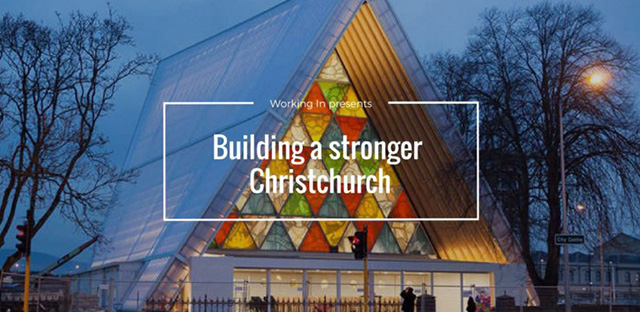It’s been 6 years since Christchurch was rocked by a series of earthquakes. This month Working In blogger James Littlewood explores the city in the throes of a rebuild to find a cosmopolitan culture overcoming the past to confront the future head on.
The worst is over, but it’s still sensitive. Despite the lingering evidence of former ordeals, Christchurch feels like a busy place, focused on pulling itself back together and – every day – finding a bit more movement than it had the day before.
The most obvious signs are in the centre: a little park opens up where there used to be a building; the iconic cathedral is still an unanswered question; a 1970s concrete block shows off its geometry under its polythene wrapping, as it reinvents itself from the inside out.
Everywhere in the centre, you see hi-vis vests, hard hats and steel caps: chippies, sparkies, engineers, and people in suits, clutching plans, together rebuilding the city from the ground up.
Amongst these guys, New Zealand accents are rare. Or rather, Kiwinese is punctuated by everything else: English, Australian, and South African accents blend with linguistic bursts of Filipino, Chinese and Polynesian dialects.
In the cafes, which are bouncing back to life in the centre, construction workers from around the world rub shoulders with business folks and intrepid tourists over paninis and lattes.
In the hard-hit suburbs to the east sit rows of mostly-intact houses, with occasional signs of damage or the odd cleared section. The river Avon wends its way past several acres of empty grass punctuated by hedges and trees, “our new park”, some call it.
Occasionally, roadworks pop up, maybe closing off a road or an intersection here and there. But you can’t really complain: it’s the rebuild in action.
The locals are used to it. “Yeah”, shrugs the pretty, tattooed girl at the local store’s check out. “But you soon figure out which routes work and which don’t. And, seriously? We’ve got better things to worry about.”
She’s right. Signs of recovery are everywhere. Optimism shines through the cracks despite everything.
New buildings are central to the recovery, literally and symbolically. They not only house people and businesses; they also give passersby indelible evidence that progress is happening.
Such as Piko, a health food store and cafe. On a nondescript street corner, it rises proudly in a brand new, purposefully designed home, bristling with solar gear, an architectural statement of defiance, pride and let’s-do-this attitude.
Another highlight, right in the city, is the Margaret Mahy Playground, named after a favourite children’s author. It’s a sprawling, diverse and ingenious place, providing welcome relief from the fenced off construction zones. It provides an awesome escape, not despite the upheaval, but precisely because of it.
A little way south, Cashel Street hosts the Re:Start Mall, a retail precinct unlike any on Earth, built entirely of shipping containers. It’s a pop-up aesthetic, with lasting appeal. They’ve renewed its temporary council permit several times already. Many of its occupants are determined to keep it just as it is, forever. They like it. It’s something they’ve grown – quite literally – out of the rubble.
And on the outskirts of town, beyond the rekindling industrial and manufacturing belt, on what used to be farmland, are a number of entirely new residential communities.
With a mixture of architectural styles, from conventional eaves to modernist monoplanes, all of them share One Big Thing: they look assertive and confident, and generally exude an air of planning, design and organisation, and of the clear intention to not let history repeat. It’s easy to imagine, inside each one of them, a person who not long ago never expected to be there at all.
More than anything, Christchurch needs people. Sure, there are jobs in construction, and if you’re a handy trade person, or engineer, or architect, there’s no shortage of stuff that needs building.
But that’s just the beginning. The rebuild is breathing life back into the wider economy, too. Retail, IT, the creative sector, administration … this is a place with things that need doing by people who care. It’s a chance to help rebuild a city, a community, and a way of life. If you’re looking for opportunity, they don’t come along like this every day.
It takes a lot to survive an earthquake: smarts, guts, planning, patience, and more than a bit of luck. So the people’s spirit is well seasoned by a turbulent past, and – as a result – well equipped for the future. Not every story’s a good one. And Christchurch isn’t out of recovery yet. But as a whole, the city may already be stronger than ever before.
The worst is over. The future is swiftly approaching, and the city is poised to reinvent itself, with new types of housing, transport, working and living. If you’re considering a move to New Zealand, you should consider a move to Christchurch, which you should start here, by checking out our job boards.

